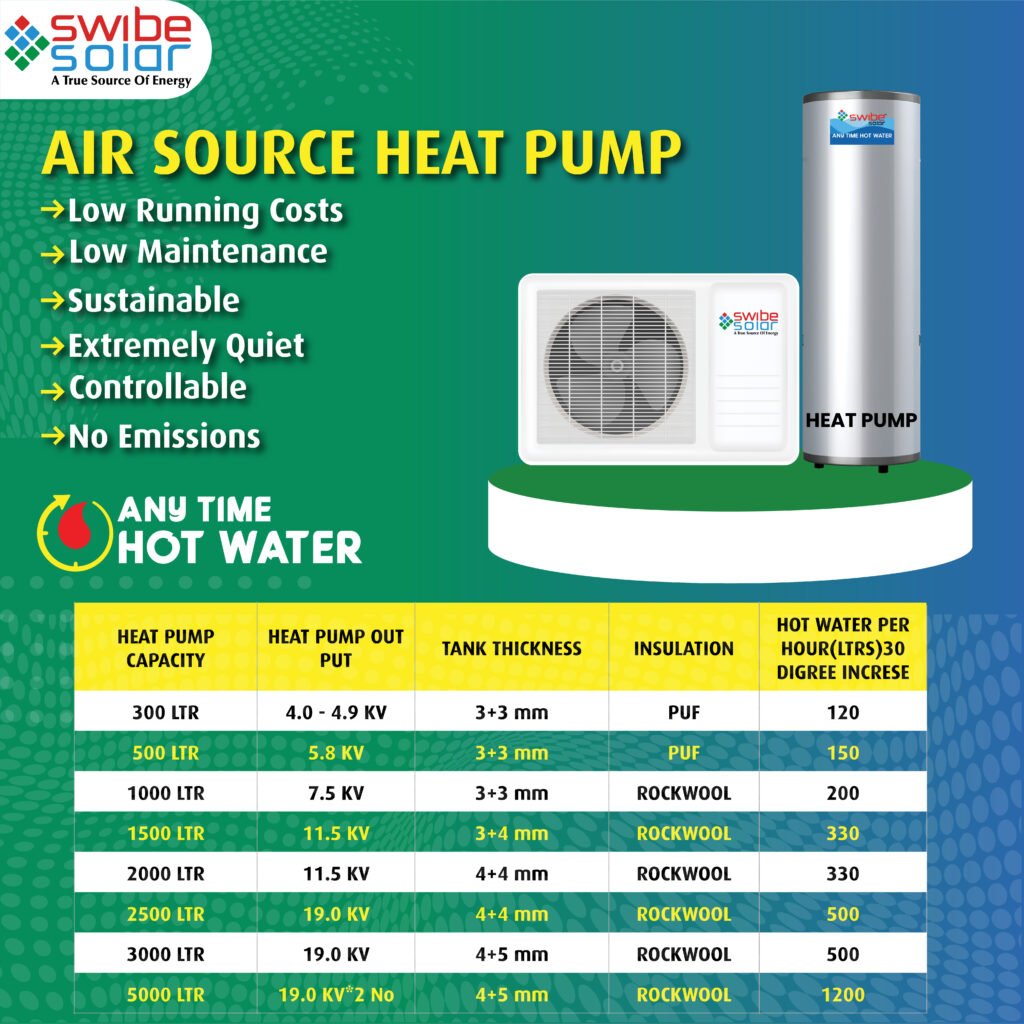
Air Source Heat Pump
Heat pump water heaters use electricity to move heat from one place to another instead of generating heat directly. Therefore, they can be two to three times more energy efficient than conventional electric resistance water heaters. To move the heat, heat pumps work like a refrigerator in reverse. While a refrigerator pulls heat from inside a box and sends it into the surrounding room, a stand-alone air-source heat pump water heater pulls heat from the surrounding air and transfers it — at a higher temperature — to heat water in a storage tank. You can purchase a stand-alone heat pump water heating system as an integrated unit with a built-in water storage tank and backup resistance heating elements. You can also retrofit a heat pump to work with an existing conventional storage water heater.
Swibe solar Heat pump water heaters are highly energy efficient as most of the energy for heating comes from the external environment, and only a fraction comes from electricity. Thus for 1KW electricity consumed the heat transferred will be 4 KW. The amount of electrical energy needed to heat water is greatly reduced compared to a conventional electric water heater in which, for 1KW electricity consumed the heat transferred is only 1KW . Thus in heat pump water heaters the coefficient of performance (ratio of output power to input power) can be as high as 4.
• Capacity: 200,300, 500 Lpd and above
Air Source Heat Pump
Air source heat pumps (ASHPs) offer several benefits as a heating and cooling solution for residential and commercial buildings. Here are some of the key advantages:
Energy Efficiency
ASHPs can provide efficient heating and cooling by transferring heat between the outdoor air and the indoor space. They typically operate using electricity but can produce more energy for heating (or cooling) than they consume, making them an energy-efficient alternative to traditional heating and cooling systems.
Lower Operating Costs
Compared to electric resistance heating or fossil fuel-based heating systems, ASHPs can result in lower operating costs, especially in regions with moderate climates. By harnessing ambient heat from the air, they can provide heating at a fraction of the cost of traditional heating methods..
Versatility
ASHPs can provide both heating and cooling, offering year-round comfort in a single system. They can extract heat from the outdoor air to warm the indoor space during colder months and reverse the process to provide cooling during warmer months, acting as both a heater and an air conditioner.
Environmental Benefits
ASHPs produce fewer greenhouse gas emissions compared to systems that rely on fossil fuels such as natural gas, oil, or coal for heating. By using electricity to transfer heat rather than burning fossil fuels directly, ASHPs can help reduce carbon emissions and mitigate climate change.
Safety
ASHPs do not involve combustion on-site, reducing the risk of carbon monoxide poisoning or fire associated with gas or oil heating systems. Additionally, they do not require on-site fuel storage, further enhancing safety.
Longevity and Low Maintenance
ASHPs typically have fewer moving parts than traditional heating systems, leading to lower maintenance requirements and potentially longer lifespans. Regular maintenance, such as cleaning filters and checking refrigerant levels, can help ensure optimal performance and longevity.
Zoning and Control
ASHPs often come with advanced control features, allowing for precise temperature control and zoning within a building. This can improve comfort and energy efficiency by heating or cooling specific areas as needed, rather than heating or cooling the entire building uniformly.
Incentives and Rebates
In many regions, governments and utilities offer incentives, rebates, or tax credits to encourage the installation of energy-efficient heating and cooling systems like ASHPs. These incentives can help offset the upfront cost of installation and improve the overall cost-effectiveness of the system.
